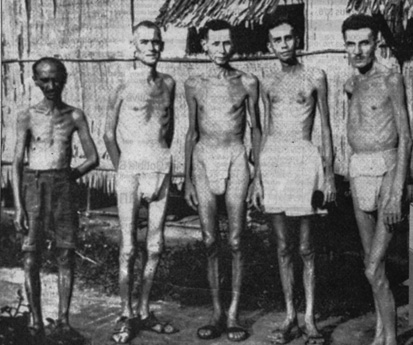The Pakan-Baru railroad |
Updated: 02/02/2010 | ||||||||
Previous historyOil and coal from the jungle of central Sumatra were the reason for the Japanese army for their war in south-east Asia [3]. In a gigantic slave project in the former Netherlands Indies, 6,000 were forced together, Netherlands and some British and Australian soldiers together with 100,000 Indonesian forced labourers, the Romushas, to build a railroad track through the impassable jungle of central Sumatra, 220 km long. The railroad track combined the cities Pakan-Baroe and Moecura and had to cross the watershed between the rivers Siak and Kwantan. It led over mountains, through narrow gorges and right through the stinking jungle swamp [4]. The works on the route began in May 1943. For this purpose, villagers of Java, called Romushas, were recruited by the Japanese with relief of later President Sukarno [2]. They were searching strong men who would be able to achieve hard work in pleasantly cool climate in comfortable camps with good food. The impression was raised by a band that they will leave for a kind of military picnic [3]. The Romushas first began in Pakan-Baroe to build a railway facility and placed some kilometres of railroad tracks [4]. To build the railway line trees were cleared, bridges built as well as thresholds and rails were produced in a handiwork manner on site [4]. |
This page: |
||||||||
The Prisoners of War are comingIn May 1944, the first Prisoners of War were added. They were brought with rusty freighters to Pandang on the western coast of Sumatra [2]. Two troop-carrying vessels were torpedoed. The Van Waervijk at the June 26th, 1944, where 176 Netherlanders drowned, and the Junyo Maru sank at the September 18th, 1944 [3]. 2,300 allied prisoners and 4,200 Romushas were on the ship when it was torpedoed by the British HMS Tradewind. 1,620 Dutch soldiers and 4,000 Indonesian Romushas were torn into death [1]. The Japanese soldiers almost took all lifeboats into their possession and with their sabres chopped of the hands of the desperate Prisoners of War trying to hold onto the boat [3]. |
|
||||||||
The life in the campDangerous it was to those who had lost her shoes during the ship disaster, they could receive small tropics ulcers on the feet [4]. Such tropics ulcers developed too from the small burns which were caused by sparks of the railway steam locomotive. Almost each fell ill with malaria and there was a crushing lack to quinine. Swarms of flies besieged the camp, in particular the open latrines. But they were to be found also in the narrow meals. Dysentery was the result. Many prisoners were brought into the hospital in camp 2, "the portal to the death" [4]. The only possibility of the cure existed for the surgeon Dr. Kingma was to amputating the limbs without stupefaction with a usual carpenter saw. Ambulance men must hold the shouting men [3]. "That was amputations which were introduced in the 16th century: only holding and sawing" [4]. Many ones died of infections [3].  The work camps were not fenced in. However, it made no sense to flee since it was impossible, to survive in the jungle. On the early morning, the Prisoners of War saw tiger trails in the wet sand of the river bank. The prisoners had a loincloth spent by Japanese that offered no protection before the dangers of the jungle as the only lining [4]. The breakfast consisted of a scoop of thickness porridge. After this they had begun to work on the railroad. A scoop of water soup and a scoop of rice were the meal for supper time. At the end of the month, they were woken at night around four o'clock in order to screw the leaden rails onto the sleepers. The Japanese hit a to the prisoners on the slightest provocation with whips [3]. Back in the camp they had to bury almost every night eight to ten dead fellows[3]. For this purpose, they were wrapped into her Tikar (sleep dull). "Uncle Karel" Cornelius, - which survived this all and passed away in 1985, - occurred as "a companion of death": he accompanied the surviving railroad workers and "talked simple words" [4]. The Indonesian Romushas were not allowed to be buried by Japanese; their corpses reclined along the railway [4]. The mood of the railroad workers was maintained by "small lectures" on Saturday. Some hundred meters away from dying comrades the "hollow looking skeletons" sang: "Dutch flag to you it dues the honour" and "In the loo and in the stable there is the white flag with the red ball". The Japanese did not understand that [4]. |
|||||||||
End of warAfter a martyrdom of 50 months, on August 15th, 1945, precise for the day of Japanese capitulation, a Japanese officer hit the last nail into the last threshold and lifted his glass with his comrades [4]. After finishing the railway construction, the Japanese and their Korean guards diverted and chaos burst from [1]. The message of Japanese capitulation was scattered only on September 26th, 1945 through a doctor. However, the most of the prisoners didn't belief the message. A Dutch officer attempted to let his fellows sing the "Wilhemums" however, it doesn't work within the rising unbelief [4]. British intelligence officers soon landed on the island and brought all prisoners to the north end of their railway just finished, to Pakan-Baroe [1]. Only at November 25th, 1945, the last Prisoner of War could leave Pakan-Baroe [2]. The railroad track Pekan-Baroe-Moecura was never used. The thresholds are burned and the rails are only scrap-iron. An unrigged steam locomotive is still standing in the operation yard at the railroad as a quiet witness of work of the Prisoners of War [4]. 2,500 western Prisoners of War - Netherlands and Englishmen - and presumably 80,000 Romushas died along "the railroad" by malnutrition and tropical illnesses in a emaciated manner, as well as half killed by Japanese and Korean guards with whips [4] [3]. |
|
||||||||
Sources:
|
 |
||||||||